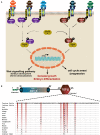Characterization of Anti-Müllerian Hormone (AMH) Gene in Buffaloes and Goats
- PMID: 33763463
- PMCID: PMC7982541
- DOI: 10.3389/fvets.2021.627094
Characterization of Anti-Müllerian Hormone (AMH) Gene in Buffaloes and Goats
Abstract
The Anti-Müllerian Hormone (AMH) is a member of the transforming growth factor beta (TGF-β) superfamily, playing a significant role in cell proliferation, differentiation and apoptosis. In females, AMH is secreted throughout their reproductive life span from ovaries, whereas in males it is secreted by gonadal cells at a very early stage of testicular development. AMH is a promising marker of ovarian reserve in women and can be used to measure the female reproductive lifespan. In the present study, we cloned and sequenced the GC rich AMH gene from Indian riverine buffalo (Bubalus bubalis) and goat (Capra hircus). Obtained sequences were compared to the AMH sequences of other mammals, and corresponding amino acid sequences revealed that the caprine and bovine AMH sequences are more closely related to each other than to those of other mammals. Furthermore, we analyzed the chromosomal localization of AMH genes in mammalian species to understand potential syntenic relationship. The AMH gene is localized between the sequences for the SF3A and JSRP1 genes and maintains this precise location in relation to other nearby genes. The dN/dS ratio of AMH gene did not indicate any pressure for either positive or negative selection; thus, the physiological function of the AMH gene in the reproduction of these two ruminant species remains very vital. Similar to other mammals, the AMH gene may be an important indicator for regulating female reproductive biology function in bovine, cetacean, caprine, and camelidae.
Keywords: Anti-Müllerian hormone; Indian water buffalo; fertility; goat; phylogenetic tree; reproduction; syntenic analysis.
Copyright © 2021 Gautam, Vats, Pal, Haldar and De.
Conflict of interest statement
The authors declare that the research was conducted in the absence of any commercial or financial relationships that could be construed as a potential conflict of interest.
Figures





Similar articles
-
Anti-Mullerian hormone (AMH) concentration in follicular fluid and mRNA expression of AMH receptor type II and LH receptor in granulosa cells as predictive markers of good buffalo (Bubalus bubalis) donors.Theriogenology. 2016 Sep 1;86(4):963-970. doi: 10.1016/j.theriogenology.2016.03.020. Epub 2016 Mar 19. Theriogenology. 2016. PMID: 27087535
-
Anti-mullerian hormone (AMH) in pregnant buffaloes: maternal and fetal plasma concentrations and immunolocalization in the fetal gonads.Anim Reprod. 2025 Feb 24;22(1):e20230152. doi: 10.1590/1984-3143-AR2023-0152. eCollection 2025. Anim Reprod. 2025. PMID: 40013122 Free PMC article.
-
Sex-dependent expression of anti-Müllerian hormone (amh) and amh receptor 2 during sex organ differentiation and characterization of the Müllerian duct development in Xenopus tropicalis.Gen Comp Endocrinol. 2016 Apr 1;229:132-44. doi: 10.1016/j.ygcen.2016.03.018. Epub 2016 Mar 14. Gen Comp Endocrinol. 2016. PMID: 26987287
-
Fertility in women of late reproductive age: the role of serum anti-Müllerian hormone (AMH) levels in its assessment.J Endocrinol Invest. 2016 Nov;39(11):1259-1265. doi: 10.1007/s40618-016-0497-6. Epub 2016 Jun 14. J Endocrinol Invest. 2016. PMID: 27300031 Free PMC article. Review.
-
Anti-Müllerian hormone: a unique biochemical marker of gonadal development and fertility in humans.Biochem Med (Zagreb). 2011;21(3):219-30. doi: 10.11613/bm.2011.031. Biochem Med (Zagreb). 2011. PMID: 22420235 Review.
Cited by
-
Single-Cell Transcriptome Sequencing Reveals Molecular Expression Differences and Marker Genes in Testes during the Sexual Maturation of Mongolian Horses.Animals (Basel). 2024 Apr 23;14(9):1258. doi: 10.3390/ani14091258. Animals (Basel). 2024. PMID: 38731262 Free PMC article.
-
Is serum AMH a suitable biomarker to determine litter size or fetal sex in goats?: A preliminary study.Trop Anim Health Prod. 2025 Feb 13;57(2):60. doi: 10.1007/s11250-025-04315-9. Trop Anim Health Prod. 2025. PMID: 39945956 Free PMC article.
References
-
- Munsterberg A, Lovell-Badge R. Expression of the mouse anti-Mullerian hormone gene suggests a role in both male and female sexual differentiation. Development. (1991) 113:613–24. - PubMed
-
- Haldar A. Age-specific peripheral anti-müllerian hormone concentration in buffaloes. J Anim Res. (2020) 10:725–32. 10.30954/2277-940x.05.2020.8 - DOI
-
- Haldar A, De S, Singh V, Datta M, Pal P, Prakash BS. Age-specific peripheral anti-müllerian hormone concentrations in goats (Capra hircus). Indian J Anim Res. (2019) 53:599–603. 10.18805/ijar.B-3569 - DOI
LinkOut - more resources
Full Text Sources
Other Literature Sources
Miscellaneous

